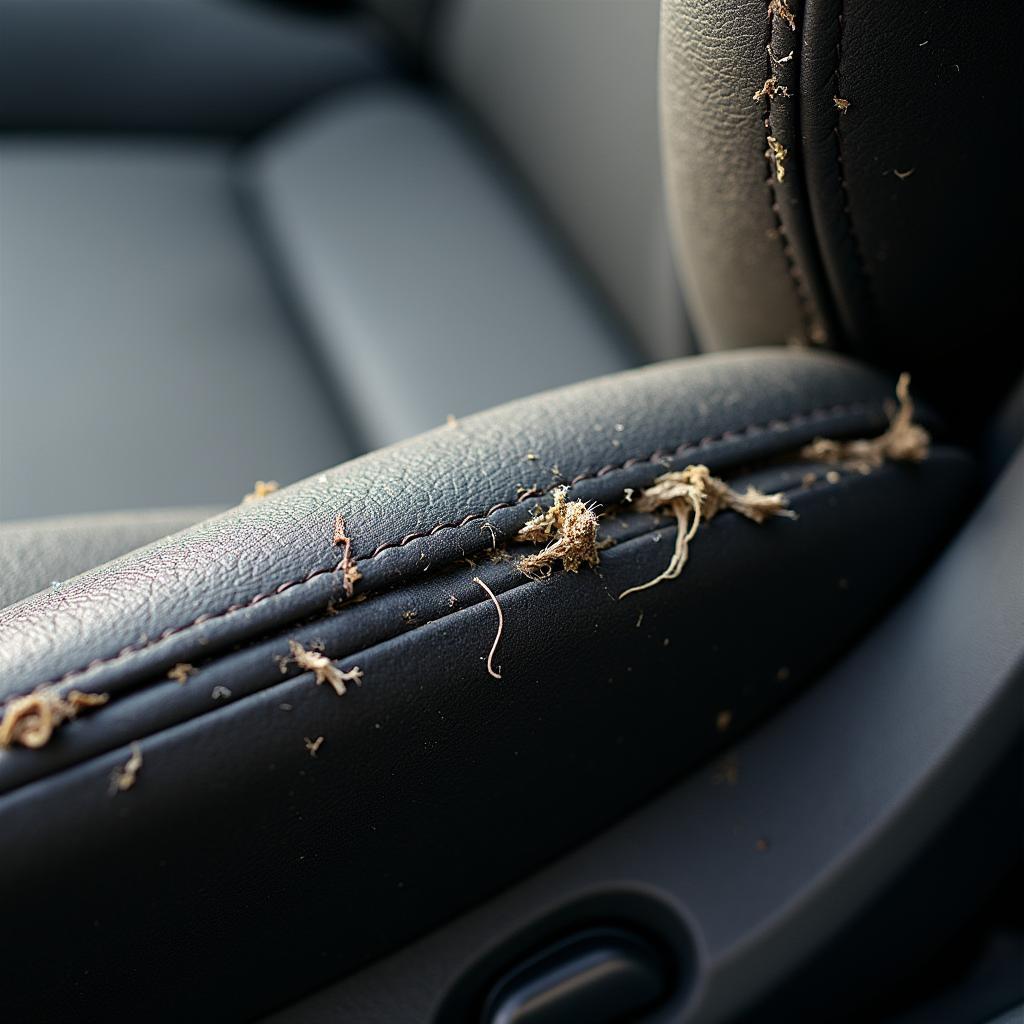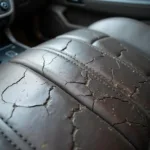Frayed car seats are an eyesore, but they don’t have to be a death sentence for your car’s interior. With a little patience and the right approach, you can repair those frayed edges and bring your seats back to life. Whether it’s fabric, vinyl, or leather, this guide will walk you through the process of tackling this common car interior issue and achieving professional-looking results right in your own garage.
Identifying the Culprit: What’s Causing Your Car Seats to Fray?
Before diving into the repair process, it’s crucial to understand what’s causing the fraying in the first place. This knowledge helps prevent further damage and ensures you use the right repair techniques. Here are some common culprits behind frayed car seats:
- Friction: Constant rubbing from getting in and out of the car is a major contributor, especially for the edges of driver’s seats.
- Sunlight: UV rays can weaken the fibers of your seats, making them more susceptible to fraying.
- Sharp Objects: Keys, tools, or even rough clothing can snag on the fabric and lead to fraying over time.
- Cleaning Products: Harsh chemicals in some cleaning agents can strip the protective coatings from your seats and make them more vulnerable.
- Age and Wear: Like any part of your car, seats naturally wear down over time.
Repairing Frayed Car Seats: Choosing the Right Method for Your Material
The best approach to repairing frayed car seats depends on the material and the severity of the damage. Here’s a breakdown of common car seat materials and the recommended repair techniques:
Fabric Car Seats: Weaving Magic with Needle and Thread
For Minor Fraying:
- Trim Loose Threads: Carefully trim any loose or excessively frayed threads with a pair of sharp scissors. Avoid cutting into the intact fabric.
- Apply Fabric Glue (Optional): For added security, apply a thin layer of fabric glue to the back of the frayed area. This helps prevent further unraveling.
- Iron-On Patch (If Applicable): If the fabric is thin or delicate, consider using a small piece of iron-on patching material for reinforcement. Follow the instructions on the package for proper application.
For Extensive Fraying:
- Consider a Seat Cover: In cases of severe damage, a seat cover may be the most practical solution. Opt for a breathable, durable material that complements your car’s interior.
Vinyl Car Seats: Patching Things Up With Vinyl Repair Kits
Minor Scratches and Fraying:
- Clean the Area: Thoroughly clean the affected area with a vinyl cleaner and a microfiber cloth to remove dirt and debris.
- Apply Vinyl Repair Compound: Using a putty knife or your finger, apply a small amount of vinyl repair compound to the frayed area. Ensure the compound fills the damaged areas evenly.
- Level and Smooth: Use the provided tools in your vinyl repair kit to level and smooth the compound, blending it seamlessly with the surrounding vinyl.
- Apply Vinyl Dye (If Necessary): If the color doesn’t perfectly match, you can apply a vinyl dye that closely resembles your car seat’s original color.
Deep Cuts or Tears:
- Consider Professional Repair: For severe damage like deep cuts or tears, it’s often best to consult a professional upholstery shop specializing in vinyl repair. They have the expertise and tools to deliver lasting repairs.
how to repair minor crack in vinyl car seat
Leather Car Seats: Restoring Luxury with Leather Repair Kits
Minor Scratches and Fraying:
- Clean and Condition: Use a leather cleaner and conditioner to prep the area. This removes dirt and ensures the repair compound adheres properly.
- Apply Leather Filler: Apply a leather filler compound to the frayed areas, using a palette knife or your finger to push the filler into the damaged areas.
- Level and Blend: Carefully level and blend the filler with the surrounding leather using the tools provided in your kit.
- Apply Leather Dye (If Necessary): If needed, use a leather dye that matches your seat’s color to create a seamless finish.
how to repair a large hole in leather car seat
Deep Cuts or Tears:
- Professional Intervention: For significant damage to leather seats, seeking professional repair from an experienced leather worker is highly recommended.
Preventing Future Fraying: Proactive Steps for Long-Lasting Seats
Prevention is always better than cure. Implementing these simple habits can significantly extend the life of your car seats and keep them looking their best:
- Regular Cleaning: Regularly vacuum and clean your seats using appropriate cleaning products for the material.
- UV Protection: Park your car in the shade or use a sunshade to protect your seats from harmful UV rays.
- Seat Covers (Optional): Consider using seat covers, especially if you frequently transport pets, equipment, or engage in activities that expose your seats to wear and tear.
- Careful Entry and Exit: Avoid sliding across your seats when getting in and out of the car.
- Prompt Repairs: Address any minor damage immediately to prevent it from escalating into a bigger problem.
Conclusion: Give Your Car Interior the Care It Deserves
Repairing frayed car seats is an achievable DIY project that can significantly enhance your car’s interior and overall driving experience. By understanding the materials, using the right techniques, and adopting preventative measures, you can keep your car seats looking their best for miles to come. And remember, for those more challenging repairs, professional help is just a phone call away.
[how to repair torn fabric car seat](https://carrepairon.com/how to repair torn fabric car seat/)
FAQs
Q: Can I use super glue to repair frayed car seats?
A: It’s not recommended. Super glue is too strong and inflexible for most car seat materials, leading to a stiff, unsightly finish. It can also damage the surrounding fabric.
Q: How often should I clean my car seats?
A: It’s recommended to vacuum your car seats weekly and do a more thorough cleaning with appropriate products every month or two, depending on usage.
Q: Are seat covers worth it?
A: Seat covers can be a great investment, especially if you’re concerned about protecting your seats from spills, stains, pet hair, or excessive wear and tear.
Q: Can I dye my car seats a different color?
A: Yes, you can dye your car seats a different color, but it requires careful preparation, the right products, and patience to achieve a professional-looking result.
Q: What should I do if the damage to my car seats is too severe to repair myself?
A: For significant damage, it’s best to consult a professional upholstery shop specializing in car interiors. They have the expertise and tools to provide lasting repairs.
Need more help? Contact us via WhatsApp: +1(641)206-8880, Email: [email protected]. We have a team ready to help you 24/7.



